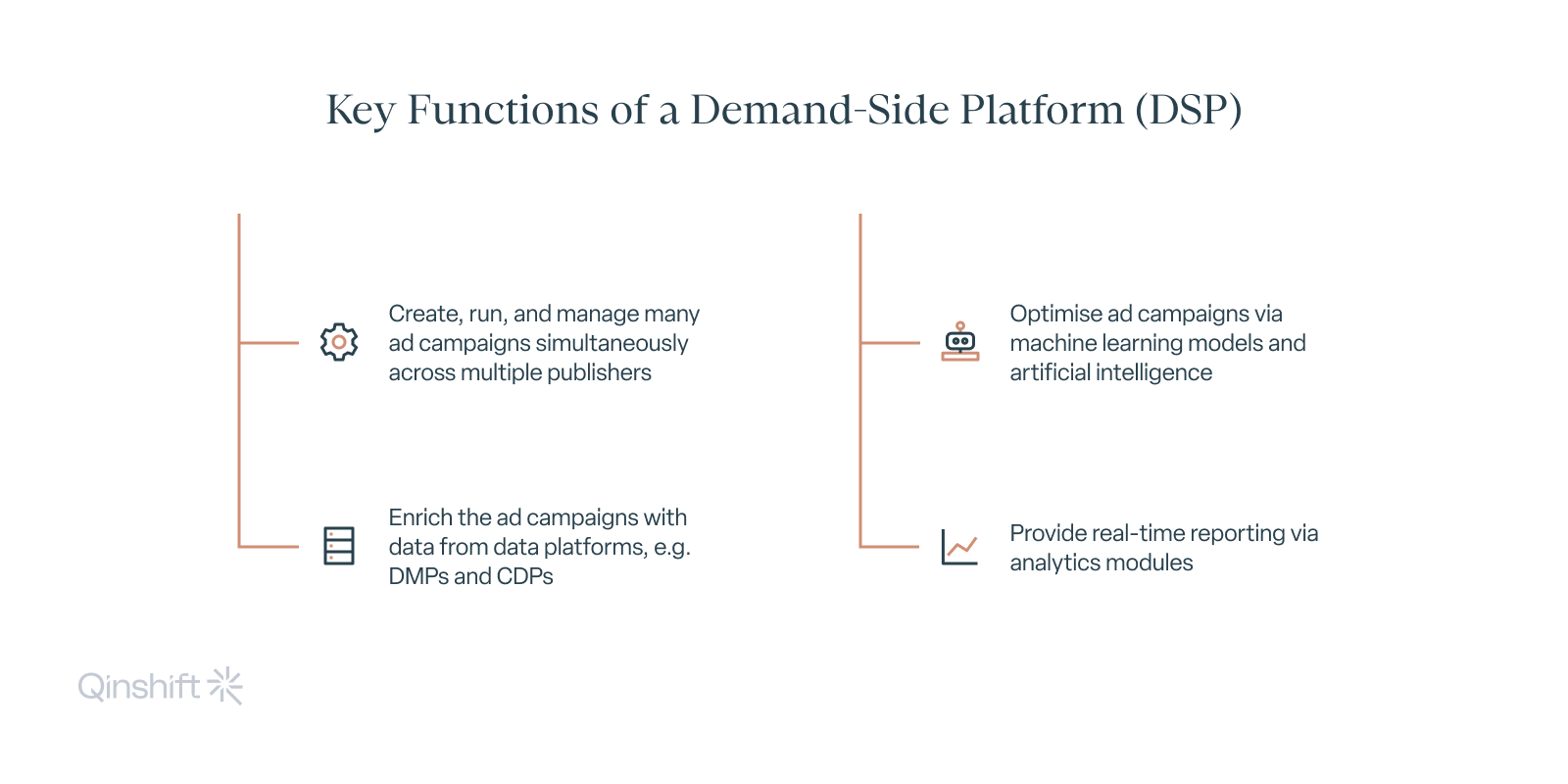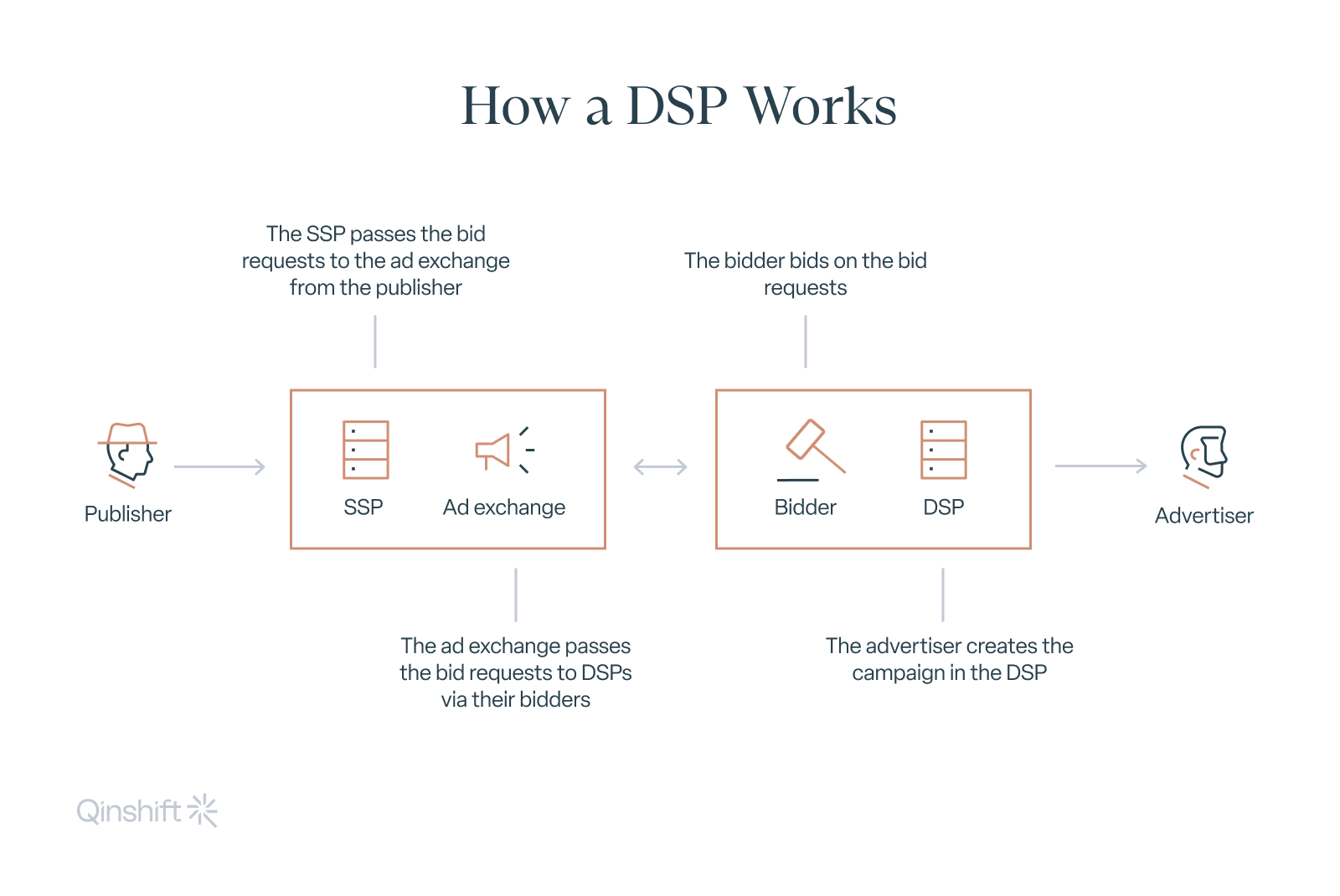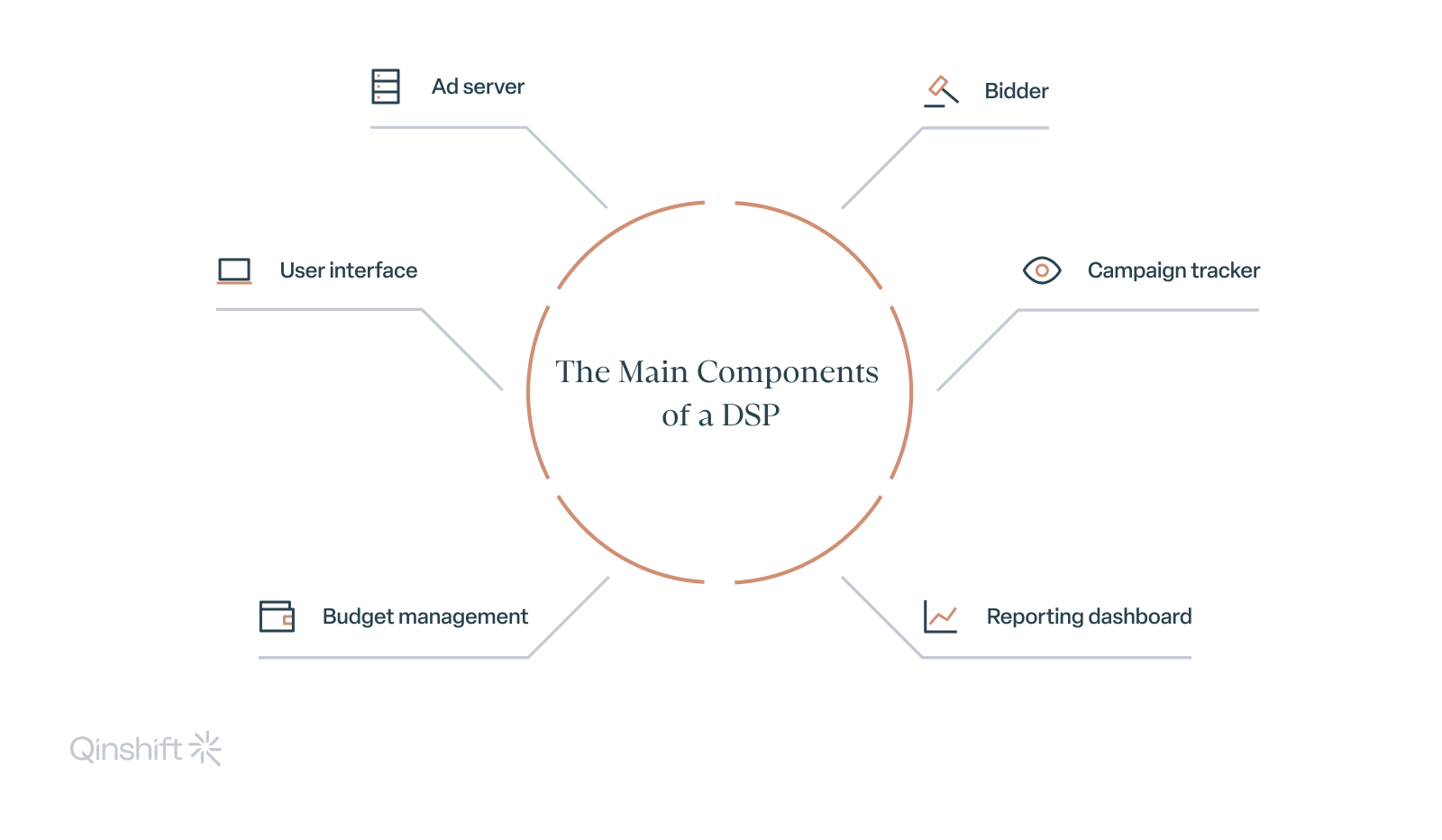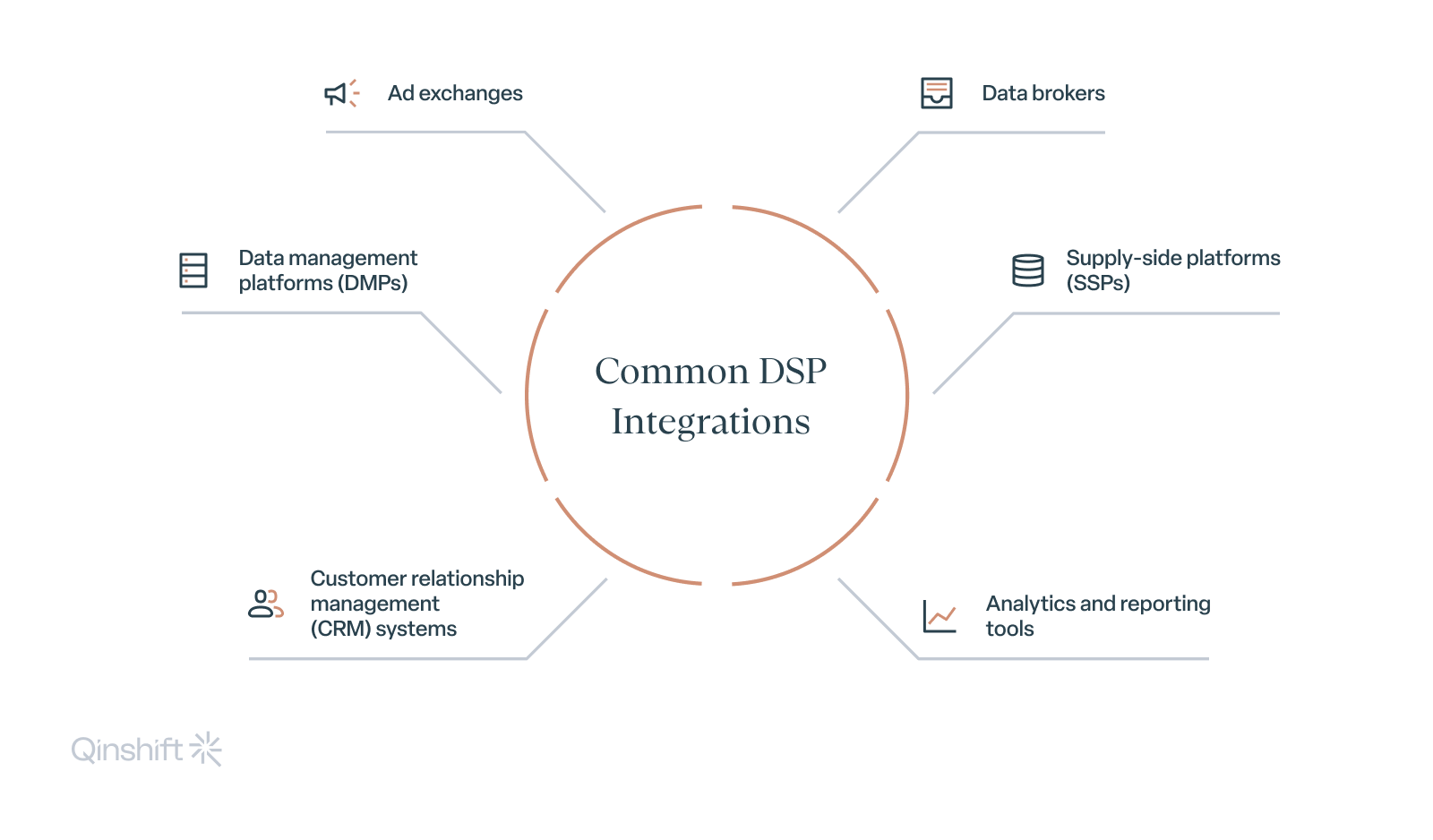What Is a Demand-Side Platform (DSP) and How Does It Work?

Demand-side platforms (DSPs) have become indispensable advertising tools, reshaping how advertisers and ad agencies reach their target audiences across the web.
This article delves into a DSP’s functions, mechanisms, and key components. We’ll also highlight the benefits of building a custom DSP for you.
Key Points
-
A demand-side platform is an AdTech platform used to buy ad inventory on an impression-by-impression basis.
-
AdOps set up advertising campaigns in a DSP. The platform then connects to ad networks and supply-side platforms (SSPs) to purchase available targeted ad impressions.
-
The main benefit of using a DSP is reaching target audiences more effectively and expanding reach to a broader audience.
What Is a Demand-Side Platform (DSP)?
A demand-side platform (DSP) is a piece of software for advertisers and ad agencies to buy ad space from publishers in a programmatic way.
Buyers can simultaneously purchase ad inventory from multiple sellers using a single user interface. In other words, a DSP provides advertisers a convenient way to buy ad impressions individually.
With a DSP, you can buy:
-
display ads — creatives in the form of banners on websites and apps;
-
video ads — video clips before, during, or after online video content;
-
native ads — creatives that match the style of the original content of the website they appear on;
-
in-app mobile ads — creatives inside mobile apps;
-
audio ads — creatives on audio streaming platforms, podcasts, and internet radio;
-
digital out-of-home ads — creatives on digital billboards;
-
connected TV ads — creatives delivered through internet-connected smart TVs and streaming devices;
-
in-game ads — creatives in video games.
DSPs connect to other AdTech platforms to buy available ad impressions and improve ad targeting. You’ll learn about these connections and their meaning for programmatic advertising in the section discussing DSP integrations.
What Can You Accomplish with a Demand-Side Platform?

Advertisers and ad agencies use demand-side platforms to increase their advertising performance. A DSP’s primary function is buying ad inventory, but the platform also serves several other functions.
AdOps and advertising specialists can manage many advertising campaigns from a single DSP. This means that they can create ad campaigns, purchase ad inventory from multiple publishers, and optimise for the best performance in terms of delivering relevant ads to the proper audiences.
DSPs also have analytics modules that enable advertisers to measure the performance of their efforts.
How Does a Demand-Side Platform (DSP) Work?
A DSP is a tool that buys ad impressions, but in order for it to work, it needs to communicate with other AdTech platforms that sell ad space for publishers: ad networks and supply-side platforms. Those platforms tell the DSP about the available opportunities and provide details about the user, meaning the person viewing the advertiser’s creative.
After you set up the advertising campaign in a DSP, including targeting criteria and creatives, the DSP starts to look for advertising opportunities and bid on the ones that match the advertiser’s targeting criteria.
Whenever the DSP can buy an ad impression, it analyses whether the information about the website or mobile app and the user, meets its targeting and ad relevance criteria. In other words, the DSP determines the user’s value to the media buyer. The real-time bidding mechanism allows the DSP to bid simultaneously for different impressions.
Upon winning a bid, the impression returns to the website and is promptly displayed to the user. This entire real-time bidding process occurs within approximately 100 milliseconds for each available impression.

What Are the Primary Components of a Demand-Side Platform?
A DSP is more than just an interface to set up ad campaigns and buy ad impressions. The platform consists of several elements, each of which is equally important.

User Interface
The UI serves as the screen where advertisers can create and oversee their campaigns, including tasks like configuring targeting, frequency capping, ad placement, and more. It also provides insights into the campaign’s performance and budget through reports.
User Profile Database
The user profile database holds information about users — for instance, the segments they are a part of — to use later with features such as frequency capping and retargeting.
Budgeting Feature
This feature controls campaign budgeting and prevents overspending.
Ad Server
Ad servers fulfil two functions in a DSP: storing creatives and the ad markup. It’s also the component responsible for presenting the ad to the user.
Bidder
The bidder places bids on available ad inventory during real-time bidding (RTB) auctions.
Campaign Tracker
The campaign tracker gathers critical ad campaign performance data — such as impressions, clicks, win notifications, etc. — and passes it to the reporting database.
Reporting Database
The reporting database processes information received from the campaign tracker to create reports out of it and display it on the user interface.
What Can You Integrate a DSP With?

You can integrate a DSP with various tools and technologies to enhance its capabilities and provide a more comprehensive advertising solution.
Some standard integrations include:
Data Management Platforms (DMPs)
Integration with DMPs to collect, analyse, and segment user data allows DSPs to leverage audience data for more targeted and personalised ad campaigns.
Data Brokers
Integration with data brokers helps DSPs enrich advertising campaigns in data and therefore improve targeting and optimisation.
Analytics and Reporting Tools
Integrating with analytics and reporting tools provides advertisers with insights into campaign performance.
Customer Relationship Management (CRM) Systems
Connecting DSPs with CRM systems helps create more personalised and targeted campaigns by syncing customer data and aligning advertising efforts with customer relationship strategies.
Supply-Side Platforms (SSPs) and Ad Exchanges
Integrating with SSPs and ad exchanges opens access to more ad inventory.
What Advantages Do You Get from Building a DSP?
Media buyers traditionally used DSPs to purchase remnant (unsold) inventory from publishers, but they’re now increasingly using them to buy available and premium inventory.
This shift in purchasing methods is primarily because DSPs offer several advantages to media buyers. Here are some of the key benefits:
-
DSPs provide the opportunity to reach target audiences more effectively and expand reach to a broader audience.
-
DSPs give access to a larger pool of ad inventory and enable advertisers to display ads on numerous channels by connecting to various ad exchanges and SSPs.
-
Media buyers can efficiently manage and optimise campaigns by adjusting settings, such as blacklisting certain websites or audiences, implementing frequency capping, retargeting across multiple ad exchanges, and behavioural profiling.
-
Real-time responsiveness to external conditions like weather, news, and stock market activity enables the serving of the most relevant ads to users.
3 Benefits of Building a Custom Demand-Side Platform (DSP)
While various DSP companies on the market offer features for advertisers and agencies, companies can benefit in several ways by developing a custom DSP.
1. Ownership of data and technology
Building a custom DSP allows you to control technology and data. This mainly benefits advertisers with extensive campaigns and agencies handling large inventory purchases.
2. Elimination of white-label fees and commissions
While creating a custom DSP doesn’t eliminate all fees, it does eliminate known costs associated with white-labelled solutions. It offers cost savings for media buyers compared to using third-party solutions.
3. Control of the product’s roadmap
Most DSPs come with features, but they may not meet every need. Developing a custom DSP grants you full control over the product’s roadmap, including specific features required by your brand or agency for your unique use cases.
Summary of Demand-Side Platforms (DSPs)
Thank you for reading our article on demand-side platforms.
DSPs play a pivotal role in modern advertising, offering efficiency, real-time capabilities, and integration possibilities that empower advertisers to reach target audiences effectively.
If there’s anything we can do for you, feel free to leave us a message and expect a reply soon!

